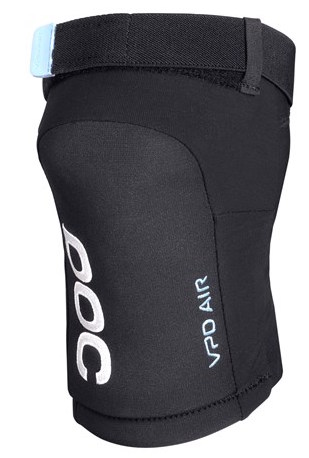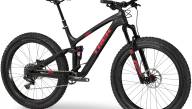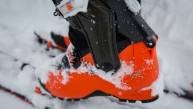.jpg.jpg) POC's new VPD Airs are half the weight of prior POC kneepads and still pack a solid amount of protection. Austin Hopkins photo.
POC's new VPD Airs are half the weight of prior POC kneepads and still pack a solid amount of protection. Austin Hopkins photo.
POC–the Swedish maker of understated bodily protection–has long attracted customers for the clean, straightforward design of their products. This is especially attractive to those in the bike world who tire of sporting gear whose designs are drawn either from motocross or road biking–two sports with some of the gaudiest aesthetics out there–and would instead prefer to have stuff that didn’t advertise that it was there in the first place. Hence POC’s all-black padding with minimal logos.

The $80.00 VPD Air knee and elbow pads came out this spring purporting to be the company’s uber-light, trail-focused pads for those who wouldn’t otherwise want to deal with the bulk of normal downhill pads on any kind of trail ride.
The VPD Air knee pads I’ve worn for the past fall and spring of riding are half the weight of POC’s normal VPD pads, dropping some of the length and weight of the pad in exchange for a smaller area of protection (protecting just above the kneecap to the top of the tibia) and slotting in a single piece of POC’s VPD padding that covers the front and sides of the knee.
VPD is a polymer dough that is highly elastic and moves with your body as you pedal and bow your knees out for a corner, and also maintains its absorption level through multiple falls, meaning that you don’t have to ditch them after the first serious tumble. The whole package is secured to your knee through good fit (more on this later), some clever use of rubber that creates friction and keeps the pad from sliding down, and a single Velcro strap at the top of the knee.
 The dexterity of the VPD Air's clean build makes them easy to climb in without feeling like they're in the way.
The dexterity of the VPD Air's clean build makes them easy to climb in without feeling like they're in the way.
I spent about four long months in these pads riding both trail and downhill, and found that the VPD Airs were extremely comfortable, breathable through the back of the knee and even, surprisingly, through the front of the knees, and that the design flexed and moved with your body so that, as long as you were on the bike and had your knees bent, you barely noticed they were there. Standing straight, the pre-bent top of the VPD padding itself pushed in towards your legs, but as long as you were riding, you didn’t notice it.
.jpg.jpg) The VPD Airs can defend against some big knocks on the downs without feeling like it. Austin Hopkins photo.
The VPD Airs can defend against some big knocks on the downs without feeling like it. Austin Hopkins photo.
Impact protection seemed to work well. I took a few slides on these but none of the direct-to-kneecap slams I can’t imagine having but have nightmares about nonetheless, and felt the VPDs stayed put and spread the impact well. Not a lot of the hit gets transferred to the body, which is great.
RELATED: The 5 biggest trends in mountain bikes for 2015
The one thing with the VPD’s is fit. You have to be very careful about your sizing, as with only one, fairly dainty elastic strap holding it on, getting a size too big, as I did, can mean you need to ghetto-strap the pads below the knee to hold them tight. Forgetting as I did that a “large” tee shirt size does not equate to a “large” kneepad size, and not at all accounting for the fact that my calves are skinnier than most bike tires, I ended up with pads that were too big and wanted to swim down my calves over the course of a downhill. The elbow pads, too, were likely ordered too big, and I actually had to flip them around so the skinniest part was hugging my bicep in order to get them to stay put on successive laps at the Whistler Bike Park.
.jpg.jpg) Get the right size, or you'll be left cutting up strips of inner tubes to make a second strap. Austin Hopkins photo.
Get the right size, or you'll be left cutting up strips of inner tubes to make a second strap. Austin Hopkins photo.
I ended up fastening the knee pads down with pieces of old inner tube below the knees and never having another problem, but if you take the $80 plunge for the VPD Air knees, pay close attention to POC’s sizing chart and measure the length of string that wraps around just above your knee or whatever knitting supplies are needed to ensure you get a proper fit. The less you’re reaching down to constantly fiddle with the strap and move the pads back up your knee, the more likely you are to wear the pads and actually get the benefit of the protection.
Once fitted, these pads strike a very nice balance between providing enough protection to ensure your knee is totally covered on all sides and still being comfortable enough that you'll be willing to wear them when you're not strictly downhilling. That being said, I use them for downhill as well and minus the potential for shin bang, don't see why not to.






















